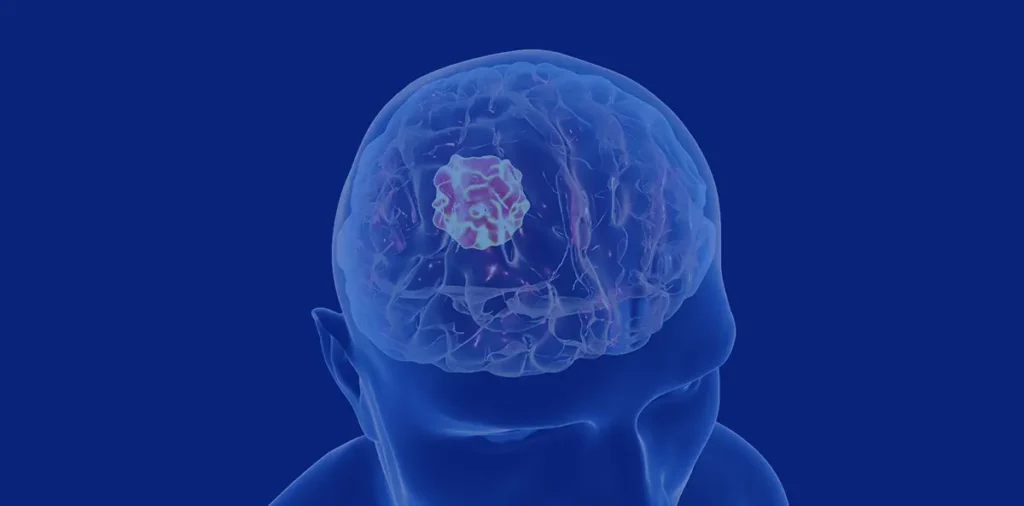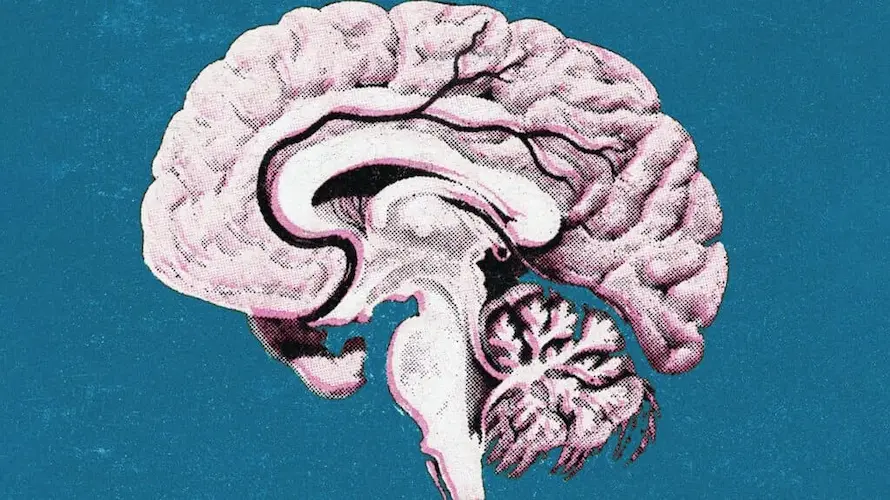Pituitary tumors are uncommon growths that develop in the pituitary gland, a small, pea-sized organ located behind the nose at the base of the brain. These tumors can cause an imbalance in hormone production, leading to various symptoms. Most pituitary tumors are non-cancerous (benign) and are also known as pituitary adenomas. They typically grow slowly and don’t spread to other parts of the body.
What is the pituitary gland?
The pituitary gland, a small, kidney-shaped structure located at the base of the brain behind the nose and protected by the sphenoid bone, plays a vital role in controlling and coordinating various bodily functions. It influences growth and development and regulates the function of organs such as the kidneys, breasts, uterus, thyroid, gonads, and adrenal glands through the release of hormones.
The pituitary gland is part of the neuroendocrine system and is closely connected to the hypothalamus, a region in the brain above it. Together, they control automatic body functions and have a significant impact on growth, development, and reproduction.
The pituitary gland consists of two regions: the anterior pituitary, located towards the front of the head, and the posterior pituitary, situated towards the back of the head. These regions differ in terms of hormone release, cell types, and developmental origins.
What are pituitary adenomas?

Pituitary adenomas, benign tumors that arise exclusively in the anterior pituitary, are relatively common, accounting for 10–15% of all intracranial tumors. While they are non-cancerous and generally non-aggressive, they can cause issues due to their sensitive location near critical brain structures, such as the optic nerves and cranial nerves.
Pituitary adenomas vary in size and hormonal activity. Tumors smaller than 10 mm are called microadenomas and are often associated with increased hormone levels, leading to noticeable changes in the body. Adenomas larger than 10 mm, known as macroadenomas, typically do not secrete hormones and are usually discovered due to the symptoms they cause by compressing nearby brain structures.
Types of Pituitary Adenomas
There are two main types of pituitary adenomas: functioning and nonfunctioning.
Functioning Pituitary Adenomas: These adenomas produce hormones and can cause symptoms depending on the type of hormone they make. They include:
- Corticotroph adenomas (which produce adrenocorticotropic hormone or ACTH)
- Somatotroph adenomas (which produce growth hormone)
- Gonadotroph adenomas (which produce luteinizing hormone and follicle-stimulating hormone)
- Prolactinomas or lactotroph adenomas (which produce prolactin)
- Thyrotropic adenomas (which produce thyroid-stimulating hormone)
Non-functioning Pituitary Adenomas: These adenomas do not produce hormones and cause symptoms due to pressure on the pituitary gland, nearby nerves, and the brain.
Pituitary adenomas vary in size and hormonal activity. Tumors smaller than 10 mm are called microadenomas and are often associated with increased hormone levels, leading to noticeable changes in the body. Adenomas larger than 10 mm, known as macroadenomas, typically do not secrete hormones and are usually discovered due to the symptoms they cause by compressing nearby brain structures.
How are adenomas generally diagnosed?
Diagnosing pituitary adenomas involves a combination of endocrinologic evaluations, neuroimaging studies like magnetic resonance imaging (MRI), and histopathologic examination of the pituitary tissue. An accurate diagnosis is essential to determining the appropriate treatment approach.
What are non-secretory adenomas?
Non-secretory adenomas, also called non-functional or silent adenomas, are larger tumors that do not produce hormones. They can cause various symptoms, including visual disturbances, headaches, and, in severe cases, hormonal imbalances affecting multiple bodily functions.
Treatment for Pituitary Adenomas
Treatment for pituitary adenomas, especially hormone-secreting ones, aims to remove or shrink the tumor mass, restore normal hormone levels, and provide necessary hormone replacement therapy as needed. Surgery is the primary treatment method, with the trans-sphenoidal approach preferred due to its decreased side effects and faster recovery times compared to traditional transcranial surgery.
Posterior pituitary tumors, such as granular cell tumors and gliomas, are rare and usually non-aggressive. Pituitary metastases, resulting from tumors that spread to the pituitary from other parts of the body, are also infrequent and present unique challenges in terms of treatment.
Symptoms of Pituitary Tumors

Pituitary tumor symptoms can vary depending on tumor size and hormone production. Some common symptoms include:
Symptoms of tumor pressure:
- Headaches
- Eye problems, such as loss of side vision or double vision
- Facial pain or sinus or ear pain
- Drooping eyelid
- Seizures
- Nausea and vomiting
Symptoms of Hormone Changes:
- Tiredness or weakness
- Sexual problems (in both men and women)
- Changes in menstrual cycles
- Feeling cold or losing or gaining weight without trying
- Specific Hormone-Related Symptoms
Cushing disease (ACTH-producing tumors):
- Weight gain and fatty tissue deposits
- Rounded face
- Stretch marks
- Thin skin that bruises easily
- Thinning of arms and legs with muscle weakness
- Thicker or more visible body hair
- Slow healing of cuts and infections
- Darkened skin
- Acne
Acromegaly (growth hormone-producing tumors):
- Changes in facial features
- Growth of hands and feet
- Thicker skin
- Increased sweating and body odor
- Joint pain
- Deeper voice (in adults)
Hyperthyroidism (thyroid-stimulating hormone-producing tumors):
- Weight loss
- Rapid or irregular heartbeat
- Nervousness, anxiety, or irritability
- Frequent bowel movements
- Sweating and tremors
- Sleep problems
Prolactinomas (prolactin-producing tumors):
- Irregular or absent menstrual cycles (in women)
- Milky discharge from the breasts (in women)
- Breast tenderness (in women)
- Fertility issues (in both men and women)
- Reduced interest in sex
Non-Secretory Adenomas
Non-secretory adenomas, also known as non-functional adenomas, do not secrete hormones and can cause general complaints due to pressure on nearby structures.
Surgical Treatment for Non-Secretory Adenomas
Surgery is the primary treatment for non-secretory adenomas, with the trans-sphenoidal approach being the preferred method for its lower risk of side effects and faster recovery times.
Posterior Pituitary Tumors
Posterior pituitary tumors, such as granular cell tumors and gliomas, are rarer and arise from glial cells or astrocytes in the posterior pituitary.
Pituitary Metastases
Pituitary metastases occur when tumor cells from other cancers spread to the pituitary.
Goals of Surgery for Hormone-Secreting Adenomas
Surgery aims to remove or shrink the tumor mass, inactivate hypersecreting pituitary tissue, and provide preoperative and postoperative hormone replacement.
Different Types of Surgery for Hormone-Secreting Pituitary Tumors
The two main surgical approaches are the transcranial approach and the trans-sphenoidal approach, with the latter being preferred due to its reduced risks and faster recovery times.
Adrenocorticotropic Hormone (ACTH) and its Impact on the Body

Adrenocorticotropic hormone, commonly known as ACTH, goes by alternative names like adrenocorticotropin and corticotropin. So, what exactly is ACTH, and how does it affect us?
ACTH is produced in the corticotroph cells of the anterior pituitary gland. It is released into the bloodstream in intermittent pulses throughout the day and circulates throughout the body. Its secretion follows a diurnal (circadian) rhythm, peaking in the morning upon waking and declining during the day, reaching its lowest levels during sleep.
Once ACTH reaches the adrenal glands, it binds to receptors, prompting the release of cortisol. This leads to an increase in cortisol levels in the blood. Additionally, ACTH stimulates the production of chemical compounds that trigger the release of other hormones like adrenaline and noradrenaline.
The regulation of ACTH involves three interconnected regions in the body: the hypothalamus, the pituitary gland, and the adrenal glands. This communication network is known as the hypothalamic-pituitary-adrenal (HPA) axis.
When cortisol levels in the blood are low, the hypothalamus releases corticotropin-releasing hormone (CRH), which prompts the pituitary gland to secrete ACTH into the bloodstream. High levels of ACTH are detected by adrenal gland receptors, leading to increased cortisol secretion, which, in turn, negatively impacts the release of CRH from the hypothalamus and ACTH from the pituitary gland, establishing a negative feedback loop.
Stress, whether physical or psychological, also stimulates ACTH production, consequently raising cortisol levels in the body.
What Happens When ACTH Levels Are Abnormal?
Too much ACTH:
Elevated ACTH levels usually increase cortisol, causing various effects. The primary cause of excess ACTH is Cushing’s disease, often caused by a non-cancerous pituitary adenoma that produces excessive ACTH. In rare cases, a tumor outside the pituitary gland, known as an ectopic ACTH tumor, can also cause excessive ACTH production.
Additionally, conditions like adrenal insufficiency, Addison’s disease (where cortisol levels are low but ACTH levels are high), and congenital adrenal hyperplasia (a genetic disorder impacting cortisol and aldosterone production) may lead to increased ACTH levels.
Too Little ACTH:
Insufficient ACTH levels can be attributed to conditions like Cushing’s syndrome due to an adrenal tumor (endogenous) or the long-term use of steroid medications for other illnesses (exogenous). In these cases, cortisol levels remain elevated despite low ACTH levels.
Furthermore, conditions affecting the pituitary gland, such as hypopituitarism or side effects of pituitary surgery or radiation therapy, can also lead to decreased ACTH production. Low ACTH levels can result in poorly functioning adrenal glands due to inadequate cortisol production.
Understanding the role of ACTH and its impact on cortisol levels is crucial to diagnosing and managing various endocrine disorders. Maintaining a balanced ACTH-cortisol relationship is essential for overall health and well-being.
When to See a Doctor
If you experience symptoms associated with a pituitary tumor, it’s essential to consult your healthcare provider. Early detection and appropriate treatment can help manage hormone levels and alleviate symptoms. In some cases, pituitary tumors may be hereditary, so discussing family history with your healthcare provider can be helpful.
Pituitary tumors, though unusual, require proper evaluation and care to ensure the best possible outcome for affected individuals.
Conclusion
The advantage of this surgery is the greater visualization of pituitary adenomas that have grown out of the confines of the normal pituitary gland and into nearby structures.
The disadvantages of this surgery are that the surgeon must expose the brain and that there is decreased visibility of the pituitary.
The complications of this surgery include damage to the brain, bleeding, infections, and vision. In addition, this type of surgery will require a longer hospital stay.














